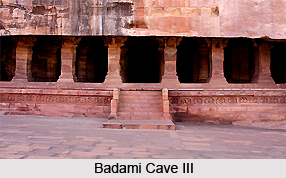 Cave 3 of Badami cave temples has impressive giant figures of Harihara, Bhuvaraha, Paravasudeva and Narasimha. These statues are engraved in a dynamic style. According to an inscription the shrine was created by Mangalesha in the twelfth year of the rule of his elder brother Kirtivarma I in 578A.D. Some of the paintings on the ceilings and the style indicate maturity. The bracket figures on the piers are one of the finest creations.
Cave 3 of Badami cave temples has impressive giant figures of Harihara, Bhuvaraha, Paravasudeva and Narasimha. These statues are engraved in a dynamic style. According to an inscription the shrine was created by Mangalesha in the twelfth year of the rule of his elder brother Kirtivarma I in 578A.D. Some of the paintings on the ceilings and the style indicate maturity. The bracket figures on the piers are one of the finest creations.
Vishnu`s Narasimha avatar is a powerful figure that radiates power and triumph. It is surrounded by celestial figures carrying flowers. There is a high possibility of Prahlada being on the right side. On the left stands Vishnu`s mount, the Garud in human form. On the pillar stands Harihara with Kama deva with bow and arrows. On the eastern wall, Vishnu sitting on the snake Sheshnag is depicted. Again on his right one can see the eagle again and on his left is Goddess Lakshmi. Below there is a group of celestial dwarfs shown playing musical instruments.
Earth is shown resting on left arm of Vishnu Varaha. In the same image snake is seen worshipping Lord Vishnu. To the east outside the verandah stands the impressive sculpture of Vishnu Virat Purush. He holds his attributes in his eight hands while Vishnu Narsimha is depicted above his head. The pillars of the verandah have very attractive sculptures.
There are eight pillars. In the first pillar beside the affectionate couple stand a Yali as well as an attractive lady. In the second pillar stands a snake-couple embracing each other. In the south stands a Sal-bhanjika looking in a mirror. In the west stands lord Shiva supporting Parvati. In the third pillar Ardhanarishvara is illustrated in the east. In the south stands a beautiful Sal-bhanjika. In the west stands a couple embracing each other. In the fourth pillar a beautiful couple standing under a tree is shown in the east. In the south again Sal-bhanjika is standing. In the west a couple embracing each other is shown. In the fifth pillar in the east Kamdev or Cupid with his wife Rati is shown. In the south a sad woman standing under a tree with two peacocks are depicted. In the west Shiva and Parvati and Kartik on his peacock are displayed. In the sixth pillar in the east an amorous couple is shown. In south a beautiful woman is shown. In the west also an affectionate couple is shown. In the seventh pillar in the east a loving couple is shown. In the west sensuous image of Lord Shiva and Goddess Parvati are shown. In the eighth pillar in the east a couple in erotic posture is shown. In the south stands an attractive lady decked with jewelry. The ceiling displays very remarkable sculptures of gods with their vehicles. These images were carved out of single pieces of stone.
Episodes from Lord Krishna`s life are depicted on the beams on top of these pillars. The churning of the ocean has also been indicated. Inside the shrine there is a huge eagle of Vishnu.



















